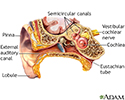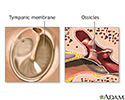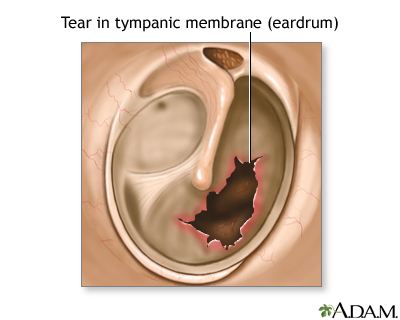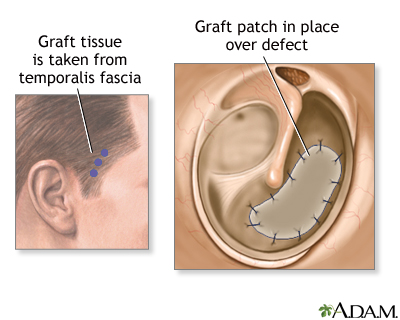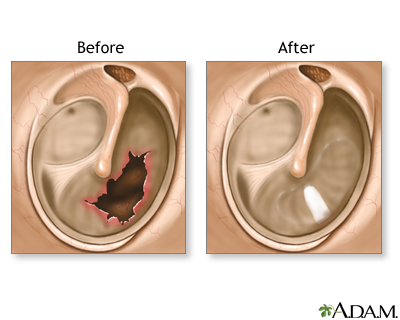Ear discharge
Drainage from the ear; Otorrhea; Ear bleeding; Bleeding from ear
Ear discharge is drainage of blood, ear wax , pus, or fluid from the ear.
Ear wax
The ear canal is lined with hair follicles. The ear canal also has glands that produce a waxy oil called cerumen. The wax will most often make its ...

Causes
Most of the time, any fluid leaking out of an ear is ear wax.
A ruptured eardrum can cause a white, slightly bloody, or yellow discharge from the ear. Dry crusted material on a child's pillow is often a sign of a ruptured eardrum. The eardrum may also bleed.
Causes of a ruptured eardrum include:
- Foreign object in the ear canal
- Injury from a blow to the head, foreign object, very loud noises, or sudden pressure changes (such as in airplanes)
- Inserting cotton-tipped swabs or other small objects into the ear
- Middle ear infection
Other causes of ear discharge include:
-
Eczema
and other skin irritations in the ear canal
Eczema
Atopic dermatitis is a long-term (chronic) skin disorder that involves scaly and itchy rashes. It is a type of eczema. Other forms of eczema include...
 ImageRead Article Now Book Mark Article
ImageRead Article Now Book Mark Article -
Swimmer's ear
-- with symptoms such as itching, scaling, a red or moist ear canal, and pain that increases when you move the earlobe
Swimmer's ear
Swimmer's ear is inflammation, irritation, or infection of the outer ear and ear canal. The medical term for swimmer's ear is otitis externa. Swimme...
 ImageRead Article Now Book Mark Article
ImageRead Article Now Book Mark Article
Home Care
Caring for ear discharge at home depends on the cause.
When to Contact a Medical Professional
Call your health care provider if:
- The discharge is white, yellow, clear, or bloody.
- The discharge is the result of an injury.
- The discharge has lasted more than 5 days.
- There is severe pain.
- The discharge is associated with other symptoms, such as fever or headache.
- There is loss of hearing.
- There is redness or swelling coming out of the ear canal.
What to Expect at Your Office Visit
The provider will perform a physical exam and look inside the ears. You may be asked questions, such as:
- When did the ear drainage begin?
- What does it look like?
- How long has it lasted?
- Does it drain all the time or off-and-on?
- What other symptoms do you have (for example, fever, ear pain, headache)?
The provider may take a sample of the ear drainage and send it to a lab for examination.
The provider may recommend anti-inflammatory or antibiotic medicines, which are placed in the ear. Antibiotics may be given by mouth if a ruptured eardrum from an ear infection is causing the discharge.
References
Bauer CA, Jenkins HA. Otologic symptoms and syndromes. In: Flint PW, Haughey BH, Lund V, et al, eds. Cummings Otolaryngology: Head & Neck Surgery . 6th ed. Philadelphia, PA: Elsevier Saunders; 2015:chap 156.
Brant JA, Ruckenstein MJ. Infections of the external ear. In: Flint PW, Haughey BH, Lund V, et al, eds. Cummings Otolaryngology: Head & Neck Surgery . 6th ed. Philadelphia, PA: Elsevier Saunders; 2015:chap 137.
Lee DJ, Roberts D. Topical therapies for external ear disorders. In: Flint PW, Haughey BH, Lund V, et al, eds. Cummings Otolaryngology: Head & Neck Surgery . 6th ed. Philadelphia, PA: Elsevier Saunders; 2015:chap 138.
O'Handley JG, Tobin EJ, Shah AR. Otorhinolaryngology. In: Rakel RE, Rakel DP, eds. Textbook of Family Medicine . 9th ed. Philadelphia, PA: Elsevier; 2016:chap 18.
-
Ear anatomy - illustration
The ear consists of external, middle, and inner structures. The eardrum and the 3 tiny bones conduct sound from the eardrum to the cochlea.
Ear anatomy
illustration
-
Eardrum repair - series
Presentation
Review Date: 5/25/2016
Reviewed By: Sumana Jothi, MD, specialist in laryngology, Assistant Clinical Professor, UCSF Otolaryngology, NCHCS VA, SFVA, San Francisco, CA. Review provided by VeriMed Healthcare Network. Also reviewed by David Zieve, MD, MHA, Isla Ogilvie, PhD, and the A.D.A.M. Editorial team.

